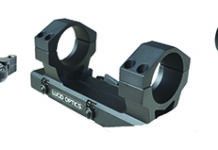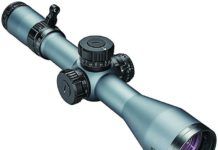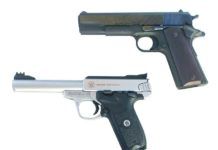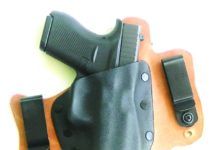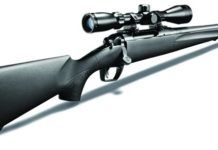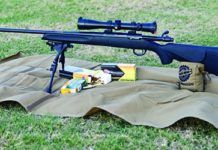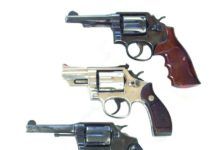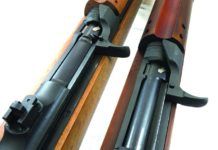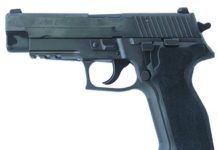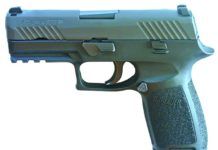Crimson Trace CTS 1250 01-00560
Quick-Release Extended Scope Mounts For Carbines & Rifles
2018 Best New Optics for Rifles, Handguns, and Shotguns
We've had a chance to use quite a few new optics this year, including red dots, lasers, scopes, binoculars, and spotting scopes, while we have performed firearms testing for future issues. We shoot a lot of firearms every year, and with that round count comes the insight that what's on top of the guns matters as much as the gun itself in many cases. Following are a few recommendations for optics that have proven themselves as worthwhile complementary products in firearms evaluations, but which we haven't tested in head-to-head comparisons as yet.
22-Caliber Handgun Shoot-Out: Smith, TacSol, Beretta, Colt
In this installment, we are looking at some of the best 22-caliber pistols for all-around target shooting and training for marksmanship and personal-defense practice, with an emphasis on viability for personal-defense training. Some handguns are just fine for general plinking, but the modern shooter demands the ability to train with combat lights or even a red-dot sight. All 22s do not allow this type of versatility. Let's look at four 22-caliber handguns and see how they stack up as modern trainers.
The 22 self-loading handgun is a great firearm that every handgunner should own at least one of. The 22 is a great trainer, and it is also a good small-game handgun, and it is even useful in some forms of competition. The absence of recoil and muzzle report compared to centerfire handguns is often touted, but recoil and muzzle blast are there, simply in easily manageable portions. The shooter is free to concentrate on trigger press, sight picture, sight alignment, and grip. Practice in offhand fire, combat practice, firing for extreme accuracy from a solid rest, clearing malfunctions and hunting game are just some of the practice that may be accomplished with the 22 pistol. For small-game hunting, excellent accuracy is demanded. For combat practice—and this is an important point—the handgun should be similar to the centerfire defense gun in accuracy. In that manner, the shooter isn't given a false sense of security by a 22 that is much more accurate than the 9mm or 45 they use for personal defense. When practicing with the 22, the serious shooter should use the same grip and trigger press that he or she uses when mastering the 9mm or 45. Using a lighter grip or shooting fast just because the 22 is so controllable doesn't cross over into personal defense skills; it is simply shooting for fun.
We collected two 22-caliber handguns and two 22-caliber conversion units for comparison. One of the handguns is a new model and the other, a relatively new and often overlooked pistol. The firearms tested included the Smith & Wesson Victory 22, Beretta Neos 22, Tactical Solutions' Glock conversion unit, and a Colt 22 Ace conversion unit.
Holsters for the Glock 42: We Test Ten for Everyday Carriers
The Glock 42 380 ACP is becoming a very successful handgun since its introduction three years ago, which has lead to many makers large and small rolling out holster rigs for this handgun. The Glock 42 is exceptionally well balanced but light, so it may require a little extra effort to be certain the Glock 42 is sheathed with a balance of speed and retention. Short and light guns sometimes roll out and require extra effort to holster securely. Fortunately, a number of makers offer good designs for this handgun, as we recently found out.
The Glock 42 is every bit a concealed carry handgun, and we think it is too important to go cheap on a holster for this activity, and you probably need more than one holster to cover all the different ways you or your spouse might carry it. Some of the holsters we tested below represent a good deal for the price and seem to do as well as others with more features. Here's what we thought about ten holsters that may suit your Glock 42 needs.
308 Winchester Bolt-Actions: Remingtons M783 Rifle Wins
Among the most useful, versatile, and powerful all-round sporting rifles is the 308 Winchester bolt action. These rifles are accurate, reliable, and can take on small to big game in many hunting conditions. When married with a good optic and in competent hands, they are well suited to take a 200-pound target at 200 yards and beyond, as a rule of thumb. The chambering is a joy to use and fire, compared to hard-kicking magnums, and offers plenty of recreational value. The bolt-action 308 is also a useful tactical rifle in many situations, and the round is widely used by law enforcement across the country.
We recently took a hard look at four bolt-action rifles chambered in 308 Winchester, with a special emphasis on looking for affordable options. So we chose two used rifles and one lower-cost new rifle and compared them to a rifle in a higher price range to ensure we weren't missing something that more dollars could provide. These rifles included the now-discontinued Mossberg ATR, the Remington 783, the Remington 700 SPS, and the Savage Axis. In this quartet, we shot three loads for accuracy testing and another load in offhand fire to gauge the accuracy of the rifles. As it turns out, the economy combination rifle that comes from the factory with a bore-sighted scope is a good deal. Though the Remington 783 was the most accurate rifle, we also liked the Remington 700 SPS a lot. Overall, however, the Savage Axis combination seems a best buy. Let's look hard at these rifles and delve into why we made these choices and to see if you agree with our assessments.
Mid-Caliber Bolt-Action Rifles From T-C, Browning, and CZ USA
Recently, we assembled a panel and arrived at what could be described as a list of practical considerations for choosing an all-around rifle. Not a specialty piece, mind you, but a "daily driver," so to speak. Our test team came up with three considerations we wanted: power, accuracy, and portability. We agreed that in terms of power, we'd like to be able to hunt at least some deer-sized animals, but not with so much power that the rifle was too heavy to carry or generate so much recoil that it was unpleasant to shoot. To us, this meant short-action calibers greater than 223 Remington but less than 308 Winchester. In terms of accuracy, it wasn't long ago that producing a 1-inch group at 100 yards (1 minute of angle) was a high standard. Certainly 1 MOA is still a benchmark, but recent state-of-the-art machinery has made it possible to buy such guns over the counter. And last, but certainly not least, there's portability. Today, that is just as likely to mean aboard an ATV as it is over the shoulder. Either way, slender and compact is still the desired profile. Thus, the focus of this test became four bolt-fed short-action rifles in medium or midrange cartridges. The lineup was as follows:
We had intended to keep the maximum length of our rifles to less than 40 inches, but we decided to include the 41.5-inch-long Thompson Center Compass because we were eager to find out if this $399 rifle chambered for 22-250 Remington had recovered since its sudden recall for safety issues. Adding to its appeal was its threaded barrel, ready for a suppressor or muzzle brake.
Our shortest rifle was also chambered for 22-250. The $859 Browning X-Bolt Micro Midas offered a Grade 1 satin-finish walnut stock with 12.5-inch length of pull and about one additional inch of stock spacers. The Micro also weighed the least, as little as 6.1 pounds unloaded.
In the middle we chose the newest model 557 from CZ USA. The Sporter Short Action chambered for 243 Winchester was perhaps the most traditional rifle, with a checkered walnut stock.
The least traditional rifle, at least in terms of appearance, was the Howa Mini Action rifle from Legacy Sports International. Its multi-cam finish, 6.5 Grendel chambering, and 10-round detachable box magazine set it apart from the others. The right size overall, we hoped the big magazine sticking out the bottom would not make the Howa too difficult to pack.
Used 38 Sp. Revolver Contest: Colt, Smith & Wesson, Ruger
Revolvers make excellent home-defense handguns. They are simple to use and reliable and will come up shooting after long periods of storage. There are no springs compressed when the revolver is loaded, and no magazines to keep up with. The revolver may be chambered for powerful and efficient cartridges, such as the 38 Special +P and the 357 Magnum. For shooters able to engage in only minimal training, the revolver makes a lot of sense. Conversely, many very experienced shooters trust the revolver and little else. The smooth-rolling double-action trigger helps avoid flinch and the rhythm, once learned, allows excellent hit probability.
We set out to find four used revolvers for this Bargain Hunter segment. They had to be high quality and chambered for either the 38 Special or 357 Magnum cartridge, with the emphasis on 38 Special. While most homeowners will load these revolvers with 38 Special ammunition, the 357 Magnum is certainly a viable option, so we tested the revolvers chambered for the Magnum cartridge with these heavy loads as well. Because we were looking for bargains, we limited the used cost to a maximum of $500 counter price. We found one revolver at that maximum and three for considerably less, including two revolvers at $300. We chose medium-frame revolvers for two of the handguns and small frames for the other two handguns.
Three were six-shot revolvers and one was a five-shooter. We elected not to pursue heavy-frame revolvers, such as the Smith & Wesson L frame or Ruger GP100, and we also did not look for J-frame type snubnose revolvers. Basically, we were looking for affordable houseguns that would do a credible job of home defense if called upon. The contenders were as follows
Reproduction M1 Carbines: We Test Auto-Ordnance and Inland Manufacturing Models
The M1 Carbine was adopted during World War II, then proceeded to arm our soldiers during the Korean War and Vietnam War, making it one of the most widely produced of all U.S. Military rifles. Millions were produced, and at one time, surplus models were quite common and inexpensive. Try finding a vintage M1 Carbine today, and you will pay close to $1000 for a well-used specimen. Costs, however, will vary dramatically depending on which manufacturer produced the M1 Carbine, the model, features, and condition.
We opted to test two new M1 Carbine reproductions, the M1 1945 Carbine from Inland Mfg. (not the original Inland Mfg. but a new company) and the M1 Carbine Paratrooper from Auto-Ordnance (A-O).
We looked at these two Carbines for historical accuracy, for competition use in M1 Carbine Matches, and as a home-defense choice. In our opinion, the Inland is suitable for all three, where the A-O is not competition ready, but it satisfies the other two roles pretty well. Bottom line, our test team found these two carbines to be reliable, depending on the ammunition employed, offer good performance if the cartridge is used within its limits, and unlike some other M1 Carbines our testers have fired in the past, these two reproductions are accurate enough for nearly any use.
2016 Guns & Gear Top Picks
Toward the end of each year, I survey the work R.K. Campbell, Roger Eckstine, Austin Miller, Robert Sadowski, David Tannahill, Tracey Taylor, John Taylor, Rafael Urista, and Ralph Winingham have done in Gun Tests, with an eye toward selecting guns, accessories, and ammunition the magazine's testers have endorsed. From these evaluations I pick the best from a full year's worth of tests and distill recommendations for readers, who often use them as shopping guides. These choices are a mixture of our original tests and other information I've compiled during the year. After we roll high-rated test products into long-term testing, I keep tabs on how those guns do, and if the firearms and accessories continue performing well, then I have confidence including them in this wrap-up.
Bigger 9mms Handguns: SIG, Arsenal, and Beretta Go At It
As noted earlier in this issue, 9mm auto-loading pistols are among the most commonly purchased firearms in America for pleasure, competition, and defense. These guns are offered in many styles and price points, ranging from a few hundred to several thousands of dollars. While the handguns in this comparison are not top-end, highly customized pistols costing thousands of dollars, they are generally marketed as being well above average quality in fit, features, and capabilities.
In this comparison, we test five pistols, three of which were built by SIG Sauer, one by Beretta, and one newcomer from Arsenal. The SIGs tested are the classic P210, the P226 MK25 used by the U.S. Navy SEALS, and the relatively new P320. The Beretta tested is the recently updated M9A3. The fifth gun is the new Strike One from Arsenal.
For our evaluation, we used three different 9mm loads from three different manufacturers in two different weights and two different bullet styles. As always, the guns in question were shot by multiple testers (this time three men and three women) of different backgrounds.
We did our accuracy testing at Boyert Shooting Centers, an indoor range in Houston, and followed the standard accuracy protocol of collecting five 5-round groups at 25 yards from a rest for each pistol/ammunition combination. For this test, we also performed a speed drill. The speed drill involved starting from a low-ready position, shooting twice to the chest and once to the head of a silhouette paper target. This test was performed at 7 yards by one experienced tester with large hands. The speed test was performed after the familiarization shooting, but before the accuracy testing. The tester was given only one opportunity to perform the test. As these pistols are supposed to be superior to the average offering, our team expected above-average results and graded accordingly. Though all five pistols turned in good results and had their fans, the testing yielded one clear surprise winner.
Big-Bore Snubnoses Around $500: Charter Arms and Taurus
We recently reviewed three 38 Special revolvers that cost about $400 and thought we would increase our budget and caliber size, and then sourced three revolvers each costing about $500 in three different big-bore calibers: 44 Special, 45 ACP, and 45 Colt, often called 45 Long Colt (LC) to ensure it's not mixed up with the Auto Colt cartridge. The three revolvers included two Charter Arms products, the Classic Bulldog in 44 Special and the newer Pitbull in 45 ACP, plus the Taurus Public Defender Polymer chambered in .410 shotshell and 45 LC.
Even though these were new revolvers, we still performed a range-rod test since there was a bit of side-to-side wiggle in the cylinders of all the revolvers. Range rods check the alignment of the chambers to the barrel bore. We also noted that the action of the Taurus seemed a bit stiff; our initial dry firing in double action found the cylinder would not fully index to the next chamber at times. Dry firing took care of the indexing issue, and all passed the range rod test. We also noted during the range-rod test the barrel of the Pitbull was not fully screwed into the frame. It was off by a fraction of a turn, enough to cock the front sight to the left when aiming the revolver. It is unacceptable that a gun leaves the factory in this condition. We anticipated and needed to use Kentucky windage with the Pitbull at the range.
In the past Charter Arms revolvers have been favorably rated, but in these two examples we found exception. The not-fully-screwed-down barrel was also the reason the cylinder-to-barrel gap was so large. We measured the gap between the front of the cylinder and the forcing cone at the rear of the barrel using feeler gauges from Brownells (606-950-252WB) and found a gap of 0.010 inches for the Pitbull and the Bulldog Classic and the Taurus at 0.005 inch. A gap of 0.003 inches is desirable for a competition revolver, but up to 0.006 inches is often found. A large gap allows more gas to escape, reducing the bullet's velocity. It also means there is more flash, and if the chamber and cylinder are not perfectly aligned, a user might experience splash from burning powders and bits of shaved bullet metal. We did not experience any splash with the Charter Arms revolvers. We did note that the Classic Bulldog had about 30 fps more than the published data for Hornady Critical Defense165-grain FTX bullet, which is 900 fps out of 2.5-inch barrel. The 3-inch barrel of Bulldog must have helped increase velocity. The Pitbull had noticeably less muzzle velocity compared to factory data. We assumed the reduction came because the Pitbull has a 2.5-inch barrel and the factory data for the cartridges use either a 4- or 5-inch barrel. Reduced muzzle velocity also occurred in the Taurus.
A common feature of all three revolvers was a safety transfer bar. This system prevents the hammer from striking the firing pin unless the trigger is pulled fully to the rear.
These revolvers are made for close-in work, but we still tested accuracy out to 25 yards. Since the Taurus offers the ability to fire .410 shotshells as well as cartridges, we sourced some CCI shot cartridges in 44 Special. CCI manufactures shotshells in 45 ACP, but warns against using the the cartridges in revolvers since the crimp that holds the shot in the cartridge case may interfere with the rotation of cylinder after being fired. One of our team members regularly carries a revolver loaded with bird shot cartridges and bullet cartridges when we walks his dog in the woods. He's equipped to deal with snakes as well as bears, depending on what chamber he lets fly.


































